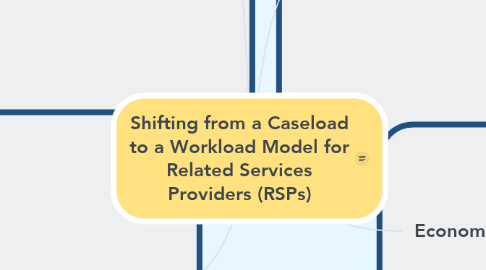
1. Environmental Factors
1.1. School Schedules
1.1.1. Daily schedules include specialty classes during which RSPs are not allowed to schedule therapy.
1.2. Therapy Space
1.2.1. Therapy often occurs in less-than- ideal environment (e.g., cafeteria, hallway, teacher's lounge) due to lack of space.
1.3. Direct Services
1.3.1. Therapy sessions, consultations, evaluations, IEP meetings, billing
1.4. Indirect Services
1.4.1. RSPs are responsible for school duties (e.g., bus, lunch, recess, dismissal/arrival).
1.5. Equity among Staff Members
1.5.1. RSPs often work from home to catch up on report writing and preparing materials due to non-therapy tasks that overload their daily work schedule.
2. Political Influence
2.1. Compliance
2.1.1. Legal IEP meetings, reports deadlines, and fulfilling service delivery and frequency as listed on IEPs and 504 plans
2.2. Regulations
2.2.1. Pub. L. 101-476 Individuals with Disabilities Education Act (IDEA) and Sec. 300.101 Free Appropriate Public Education (FAPE)
2.3. Adminstrations
2.3.1. Administrators are non-union members, so they tend to side with the district rather than the staff.
3. Personal Factors
3.1. Coping Styles
3.1.1. RSPs are required to adapt quickly to provide therapy for a wide variety of populations (e.g., ASD, physical or intellectual impairments).
3.2. Handling Responsibilities
3.2.1. Difficulty to carry out different roles (e.g., bus/lunch staff, consultant, tech/devices troubleshooting, therapist, assessor, clinical supervisor)
3.3. Psychological Demands
3.3.1. Constantly overworked and stressed with legal due dates (IEP meetings and report writing) and dealing with family complaints about missing therapy sessions
